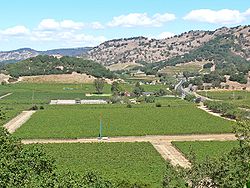Californian wine
California wine is wine made in the U.S. state of California. Almost three quarters the size of France, California accounts for nearly 90 percent of American wine production. The production of wine in California alone is one third larger than that of Australia. If California were a separate country, it would be the world's fourth largest wine producer.
The state's viticultural history dates back to the 18th century when Spanish missionaries planted the first vineyards to produce wine for Mass.
Today there are more than 1,200 wineries in the state, ranging from small boutique wineries to large corporations with distribution around the globe.
The state of California was first introduced to Vitis vinifera vines, a species of wine grapes native to the Mediterranean region, in the 18th century by the Spanish, who planted vineyards with each mission they established. The wine was used for religious sacraments as well as for daily life. The vine cuttings used to start the vineyards came from Mexico and were the descendant of the "common black grape" (as it was known) brought to the New World by Hernán Cortés in 1520. The grape's association with the church caused it to become known as the Mission grape, which was to become the dominant grape variety in California until the 20th century.
The California Gold Rush in the mid-19th century brought waves of new settlers to the region, increasing the population and local demand for wine. The newly growing wine industry took hold in Northern California around the counties of Sonoma and Napa. The first commercial winery in California, Buena Vista Winery, was founded in 1857 by Agoston Haraszthy and is located in Sonoma, California. John Patchett opened the first commercial winery in the area that is now Napa County in 1859. During this period some of California's oldest wineries were founded including Buena Vista Winery, Gundlach Bundschu, Inglenook Winery, Markham Vineyards and Schramsberg Vineyards. Chinese immigrants played a prominent role in the developing the Californian wine industry during this period - building wineries, planting vineyards, digging the underground cellars and harvesting grapes. Some even assisted as winemakers prior to the passing of the Chinese Exclusion Act which severely affected the Chinese community in favor of encouraging "white labor." By 1890, most of the Chinese workers were out of the wine industry.
...
Wikipedia

